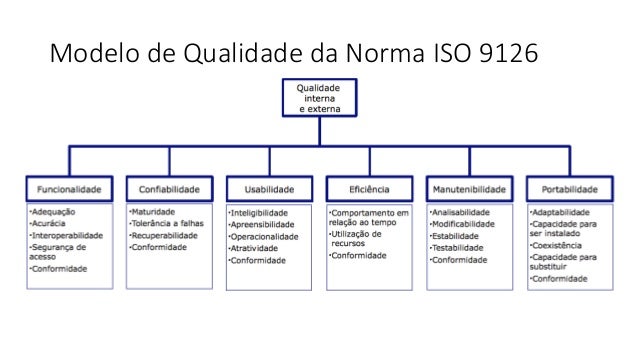Normas Iso 9000 Iso Iec 9126
The quality criteria according to ISO 9126The fundamental objective of the ISO/IEC 9126 standard is to address some of the well known human biases that can adversely affect the delivery and perception of a software development project. These biases include changing priorities after the start of a project or not having any clear definitions of 'success'. By clarifying, then agreeing on the project priorities and subsequently converting abstract priorities (compliance) to measurable values (output data can be validated against schema X with zero intervention), ISO/IEC 9126 tries to develop a common understanding of the project's objectives and goals.The standard is divided into four parts:.
quality model. external metrics. internal metrics. quality in use metrics. Contents.Quality The quality model presented in the first part of the standard, ISO/IEC 9126-1,classifies in a structured set of characteristics and sub-characteristics as follows:. Functionality - 'A set of attributes that bear on the existence of a set of functions and their specified properties. The functions are those that satisfy stated or implied needs.'
. Accuracy. Functionality compliance. 'A set of attributes that bear on the capability of software to maintain its level of performance under stated conditions for a stated period of time.' . Maturity.

Recoverability. Reliability compliance. 'A set of attributes that bear on the effort needed for use, and on the individual assessment of such use, by a stated or implied set of users.'
. Understandability.
Attractiveness. Usability compliance. 'A set of attributes that bear on the relationship between the level of performance of the software and the amount of resources used, under stated conditions.' . Time behaviour. Resource utilization. Efficiency compliance.
'A set of attributes that bear on the effort needed to make specified modifications.' . Analyzability. Changeability. Stability. Maintainability compliance.
'A set of attributes that bear on the ability of software to be transferred from one environment to another.' .
Normas Iso 9000 Iso Iec 9126 Quality Model
Adaptability. Installability. Co-existence.
Replaceability. Portability complianceEach quality sub-characteristic (e.g. Adaptability) is further divided into attributes. An attribute is an entity which can be verified or measured in the software product. Attributes are not defined in the standard, as they vary between different software products.Software product is defined in a broad sense: it encompasses executables, source code, architecture descriptions, and so on. As a result, the notion of user extends to operators as well as to programmers, which are users of components such as software libraries.The standard provides a framework for organizations to define a quality model for a software product. On doing so, however, it leaves up to each organization the task of specifying precisely its own model.
This may be done, for example, by specifying target values for quality metrics which evaluates the degree of presence of quality attributes.Internal Metrics Internal metrics are those which do not rely on software execution (static measure).External metrics External metrics are applicable to running software.Quality-in-use metrics Quality-in-use metrics are only available when the final product is used in real conditions.
ISO/IEC TR 9126-4:2004 provides quality in use metrics for measuring the attributes defined in ISO/IEC 9126-1. ISO/IEC TR 9126-2 defines external metrics and ISO/IEC TR 9126-3 defines internal metrics for measurement of the subcharacteristics defined in ISO/IEC 9126-1. Internal metrics measure the software itself, external metrics measure the behaviour of the computer-based system that includes the software, and quality in use metrics measure the effects of using the software in a specific context of use.The metrics listed in ISO/IEC TR 9126-4 are not intended to be an exhaustive set.